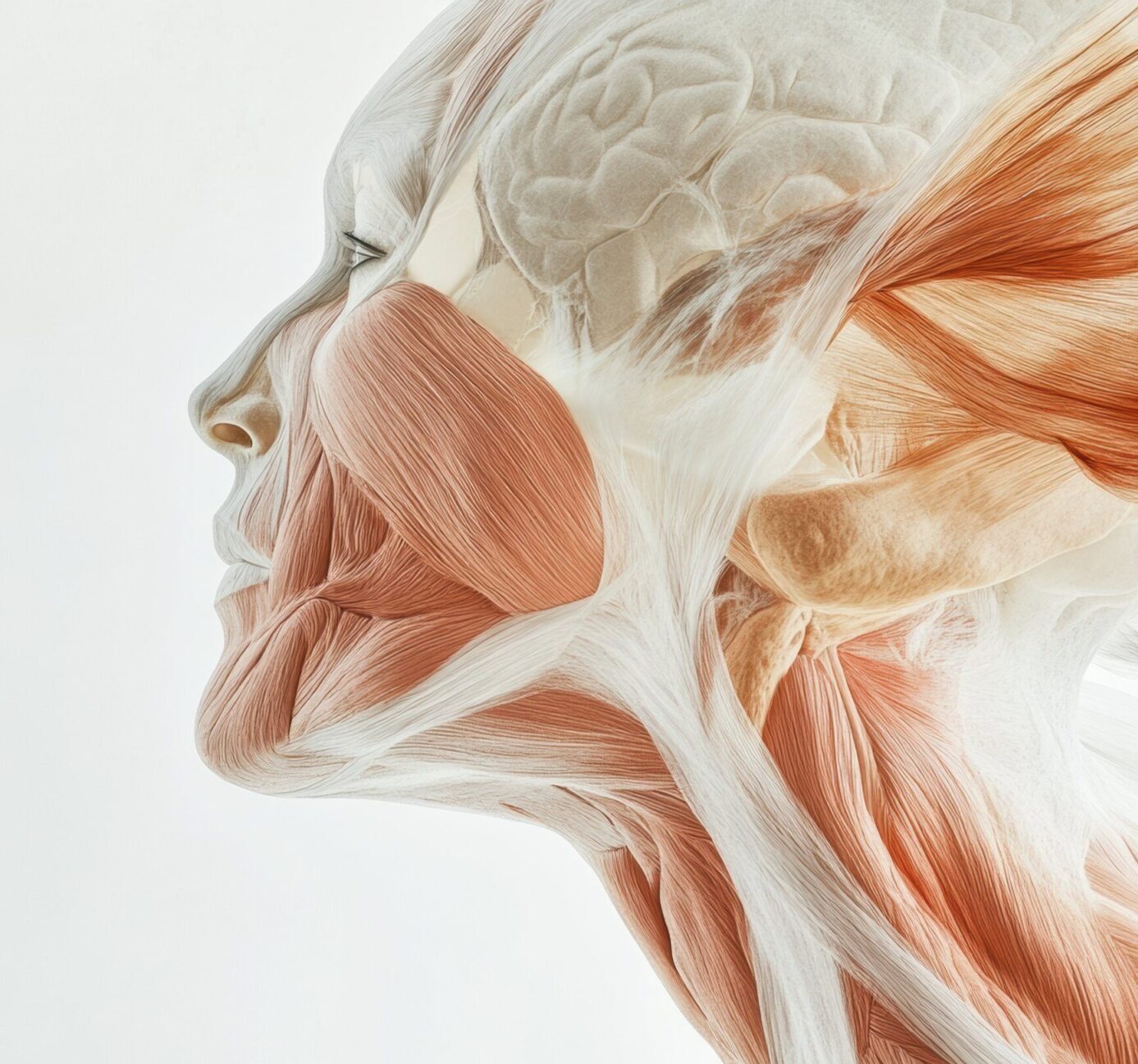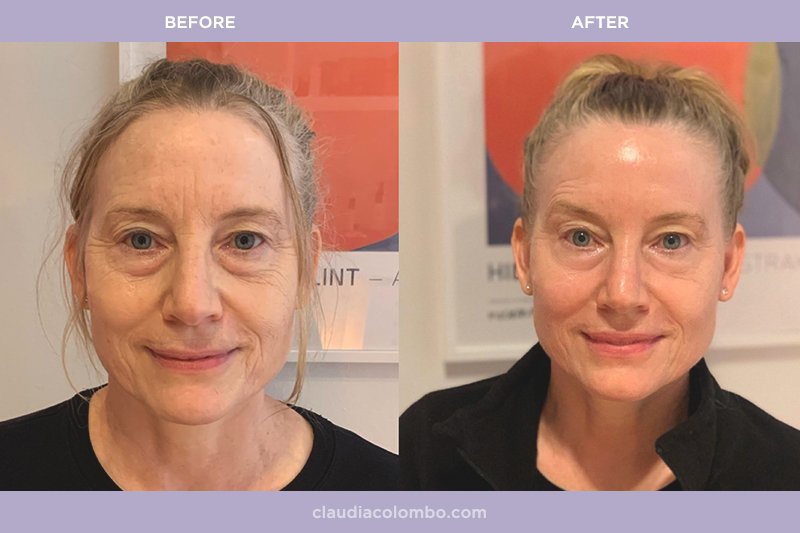With 30 years of experience as a holistic aesthetician and bodyworker, I’ve come to believe that true beauty and aging gracefully are rooted in inner work. The condition of our inner selves is mirrored on our faces, making the face a vital component of our identity. It reflects the state of our body, mind, and emotions, as well as our physiological and physical health. Our faces and skin are like canvases, offering insights into our health, potential imbalances, personality, and overall disposition.
When we work with the face, we’re engaging with the complex intricacies of the entire body—encompassing cells, muscles, nerves, fascia, and lymph. Every system is interconnected, and in touching the face, I am also indirectly addressing the organs that align with it. Skin issues are rarely just superficial concerns; more often, they are signs of internal disharmony within the body.
One fascinating organ to delve deeper into is the fascia—a crucial component often overlooked. Yes, the fascia is indeed an organ, deserving of our attention and exploration!
Focusing on fascia is essential for those seeking to age gracefully, radiantly, and with vitality. I view fascia as the cornerstone of longevity and vibrant aging. Additionally, I believe there’s a significant link between bodily trauma and chronic pain. My lifelong healing journey has brought me full circle, revealing the many secrets fascia holds within my own unique story—beginning with multiple head traumas at the tender age of three, and a debilitating accident at 17, which led to chronic back pain, TMJ, and recurring concussions.
I’ve uncovered some of these secrets through my healing path and skin rejuvenation, and I’m eager to share the possibilities for your healing journey. Fascia has been overlooked for far too long in the context of healthy aging and skin rejuvenation. With ongoing research, we are gradually unraveling its intricate web of mystery and performance, offering new insights and opportunities for health and beauty.
What is Fascia?
Fascia, essentially is connective tissue. The connective tissue that separates but also connects our bones, muscles, veins, organs, and even our cells. However, it is much more than tissue–it’s a highly complicated, sensory SOPHISTICATED organ. The largest organ of our body, unlike the popular belief that the skin is our largest organ. Fascia is the only system that connects and passes through our entire body and even penetrates the brain. It also communicates faster than our nervous system, like a communication highway of sorts between every cell in the body forming a continuous 3D web of connective tissue made up of collagen fibers. It creates stability and form in the face and body and provides internal structural support when kept healthy. Without its structure, we would be a pile of bones and muscles walking around like loose puppets. And traumas or scars to any area of the body can lead to problems in other areas by disrupting this connective tissue web. Over time these adhesions can lead to changes in facial appearance such as skin wrinkles and sagging or drooping skin.
Due to the unique relationship between our facial skin and facial muscles, the healthy movement of facial fascia is imperative to the nervous, muscular, and circulatory functions of our face. There are two layers of fascia on the face. Superficial fascia is the layer of connective tissue right under the skin on the face. It acts as the support and infrastructure for your skin and is responsible for giving it lift and tone. It can also carry tension and adhesions that restrict the circulation of blood and lymph.
Deep fascia is a tougher, more dense connective tissue that connects your skin to the muscle and fat below and forms a “girdle” of facial muscles known as the SMAS (superficial musculoaponeurotic system). The deep fascia includes temporalis fascia, parotid–masseteric fascia, investing fascia of the neck, periosteum, and orbital septum. The superficial facial fascia invests the superficially situated memetic muscles (platysma, orbicularis oculi, and zygomaticus major and minor).
Illustration by ELSIEVR.ORG
“Over time fascial adhesions can lead to changes in facial appearance such as skin wrinkles and sagging or drooping skin”
Having fascia stay healthy holds the key to tackling chronic pain, immune dysfunction, depression, and face, and body aging. When unhealthy, it can become sticky, thick, dry, and tight, causing adhesions and restrictions. Fascial adhesions, also known as scar tissue adhesions (or fibrous adhesions) are composed of fibrous fascia collagen fibers. These collagen fibers are the same substance that makes up tendons, ligaments, and other fibrous fascial tissues. Nerve and vascular structures that come through the SMAS layer can become entrapped through fascial adhesions causing pain, lack of movement, lymphatic system restriction, and inflammation. It can affect mood, energy, insomnia, and mobility. Fascial adhesions can occur from trauma, injury in a fall or concussion, chronic stress, emotional trauma, surgical procedures, repetitive facial movements, inflammation, facial fillers, injections, and scar tissue formations.
Over time these adhesions can lead to changes in facial appearance such as skin wrinkles and sagging or drooping skin. This can result from the fascia growing out and lengthening. Since the skin on the face is attached to the fascia, it begins to fall with it. If the fascia is restrictive and stiff it will hold deeper facial wrinkles “in place” until released. To release these adhesion requires a few different techniques, one of which can be fascia scraping using the Fascia Sculpting Beauty Tool.
The skin of the face is uniquely connected to the facial muscles and the aging fascia causes elongation and heaviness this is fascia that’s decompressed and needs to tension released and to be strengthened and toned again.
Check out this video explanation of what you’re seeing when your face starts to look heavier and older.
“Traumas or scars to any area of the body can lead to problems in other areas by disrupting this connective tissue web”
AFTER THE FASCIA RESET FACIAL
What can you do to care for the facial fascia?
If you’re noticing jowls and heaviness in the jawline, tension in the body needs to be released before moving to that area to help “fix” it. It’s usually coming from tension in the neck and chest, this is a good place to start to release. Watch thisvideo on my Instagram channel to learn more.
Healthy fascia is slippery, smooth, and stretches easily. Damage to the fascia, for example in physical impact leading to trauma can damage it when left too long and can cause a ton of pain, restrictions, illness, and disease–if not treated because the face and body are deprived of energetic and nutritional nourishment the fascia provides. When restricted it can hold “in place” deeper wrinkles or sag in place until released. Fascia can constrict in many different ways, therefore blocking optimal blood and lymph flow to the skin. I’ve implemented these methods to improve my appearance, help keep my fascia healthy, and increase mobility for years.
-
FASCIA RESET FACIAL – Releases adhesions and restructures the face using the Fascia Sculpting Plate and more. Since fascia has thermo receptors it enjoys heat! Essentially, in the Fascia Reset Facial what I try and do first is warm up the tissue, so that tissue can relax and be malleable. True fascia care starts with the whole body not just the face, then preparing it for drainage to optimize proper blood and oxygen to all the cells.
-
JET PEEL Lymphatic Drainage – Fascia also responds to cold adding the Jet Peel cryo treatment and doing a Jet Detox lymph drainage is effective.
-
MICROCURRENT-Fascia is a superconductor of energy! Microcurrent is another wonderful skin and body modality that fascia responds to beautifully. Microcurrent works by delivering an electrical current to muscles and skin cells. The idea behind this is that the electrical current will build up muscles in the face, lifting and tightening the skin.
-
GUASHA-The benefits of facial massage—specifically the practice of gua sha—include relieving facial tension, toning facial muscles, boosting circulation, reducing puffiness, and improving product absorption.
-
MYOFASCIAL MASSAGE- Myofascial massage can improve the aging face. “Myo” means muscle. “Fascial” refers to the connective tissue that covers and supports the muscles throughout your entire body. During myofascial release therapy, your therapist doesn’t focus specifically on your muscles. We focus on releasing tension in your fascial connective tissues.
-
CUPPING-Suction from cupping draws fluid into the treated area. This suction force expands and breaks open tiny blood vessels (capillaries) under your skin. Your body replenishes the cupped areas with healthier blood flow and stimulates proper and normal healing at a cellular level.
-
BUCCAL MASSAGE- Intra-oral (buccal) massage that relaxes parts of your musculature where tension is stored opening up space in the mouth to promote blood circulation and oxygenation of the skin. The lines around the mouth are smoother, the skin is tighter and the lips become naturally plumped. It creates a natural lift and provides symmetry to the face. It also promotes lymphatic drainage to reduce puffiness and leave behind a deep glow. By releasing contracted muscles and fascia this treatment can also help reduce wrinkles in the face that are caused by excess tension.
Integrating facial services and modalities with bodywork practices can support maintaining healthy and flexible fascia. Yoga plays a vital role in twisting and detoxifying the internal organs, ensuring they remain clean and nourished with oxygen and blood. Similarly, Pilates and dancing stretch the fascia, facilitating the movement of water within us and generating an energetic charge.
By releasing adhesions and incorporating compression therapies, along with stretch-and-hold techniques and deep diaphragmatic breathing, you activate your internal furnace. This approach nourishes your cells, aligns your posture, and ultimately results in glowing, radiant skin and overall health.
-
ACUPUNCTURE
-
YOGA
-
DEEP BREATHING
-
PILATES
-
DANCING
-
ROLLING
-
TUINA MASSAGE
-
ROLFING
-
DRY NEEDLING
- Caring for your fascia is not a one-time task; it’s a lifelong commitment that involves incorporating wellness practices and attentive lifestyle choices into your daily routine. This dedication is key to aging with vitality and vigor. Fascia has a strong hold, and since everyone’s holding patterns are uniquely their own, it’s important to approach this process slowly with patience. Remember to breathe deeply and allow yourself to release tension gradually. I look forward to helping you! Book your session or virtual consultation.
Join The Waitlist for my live Fascia Connection workshop and course.
With Care, Love & Light
xo
Claudia



Comments +